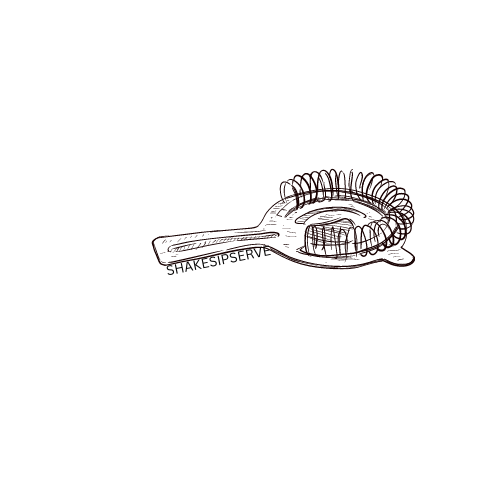Explore our ultimate guide to the best cocktail strainers and elevate your drink-making skills with ease.
Welcome to Shake, Sip, Serve, your one-stop shop for all things bartending.
I’m your host, KAD, and I’ve been slinging drinks and navigating the world of hospitality for over two decades.
The past 15 years, I’ve perfected my bartending skills, experimented with countless flavor combinations, and learning a thing or two about how to keep the party going behind the bar.
Whether you’re a seasoned bartender like me just looking for some fresh inspiration or a complete beginner who is eager to whip up impressive cocktails at home, Shake, Sip, Serve is here to be your guide.
In the below blog, I’ll be sharing my knowledge and experience on everything from classic cocktails and innovative new creations to essential bartending techniques and industry secrets. I’ll also be offering tips on stocking your home bar, mastering the art of presentation, and creating a memorable experience for your guests.
So, grab your shaker, dust off your favorite glassware, and get ready to embark on a delicious journey into the world of bartending!
Let’s Shake, Sip, and Serve up something amazing together.
Disclaimer: This post contains affiliate links. If you purchase through these links, I may earn a small commission at no additional cost to you.
The cocktail strainer, often an unsung hero of the bar, plays a crucial role in transforming a collection of ingredients into a refined and enjoyable drinking experience. More than just a sieve, it’s a precision instrument that dictates the texture, clarity, and overall presentation of a cocktail. This comprehensive guide explores the world of cocktail strainers, examining their importance, various types, proper usage, maintenance, and historical evolution.
Why Cocktail Strainers are Indispensable:
Cocktail strainers are essential for separating solid particles from the liquid components of a cocktail. This crucial step ensures a smooth, palatable drink free from ice shards, fruit pulp, herb fragments, and other unwanted residue. Beyond textural refinement, strainers contribute to the visual clarity of a cocktail, enhancing its aesthetic appeal and professional presentation. They also play a role in controlling dilution; by removing ice, they prevent over-watering the drink. In essence, the strainer is a key component in achieving the desired balance of flavors, texture, and appearance that defines a well-crafted cocktail.

The Multifaceted Role of Strainers in Cocktail Creation:
- Solid-Liquid Separation: The primary function of a cocktail strainer is to effectively remove solid ingredients, such as ice, muddled fruits, herbs, and spices, from the liquid portion of the drink. This separation is crucial for achieving the desired consistency and preventing unwanted textures in the final cocktail.
- Texture Management: Strainers play a vital role in controlling the texture of a cocktail. By removing fine particles, they create a smooth, refined mouthfeel, enhancing the overall drinking experience. This is particularly important for cocktails that are shaken or muddled, where small particles can easily become dispersed throughout the liquid.
- Visual Presentation: The clarity and appearance of a cocktail are significantly influenced by proper straining. Removing solid particles creates a visually appealing drink, free from cloudiness or sediment. This attention to detail contributes to a professional and polished presentation.
- Dilution Control: Strainers assist in managing the dilution of a cocktail. By removing ice after shaking or stirring, they prevent the drink from becoming overly watered down, ensuring that the intended flavor profile is preserved.
A Comparative Analysis of Common Cocktail Strainer Types:
Several types of cocktail strainers exist, each designed for specific purposes and offering distinct advantages.
- Hawthorne Strainer: The most ubiquitous cocktail strainer, the Hawthorne, features a flat, perforated metal disc with a coiled spring encircling its edge. This spring acts as a filter, trapping ice and larger particles while allowing the liquid to flow through. The Hawthorne is versatile, suitable for both shaken and stirred cocktails, and its adjustable spring allows it to fit a variety of shaker sizes.
- Julep Strainer: Resembling a perforated spoon or scoop, the Julep strainer is a classic tool traditionally used for straining drinks directly from a mixing glass. Its concave shape fits snugly inside the glass, allowing for a controlled pour while retaining ice and larger solids. While historically associated with mint juleps, the Julep strainer is now used for a wider range of stirred cocktails.
- Fine Mesh Strainer (Conical Strainer): Also known as a tea strainer or chinois, the fine mesh strainer is a small, conical strainer with a very fine mesh. It’s used in conjunction with other strainers for “double straining,” a technique that removes even the smallest particles, resulting in an ultra-smooth and refined cocktail. The fine mesh strainer is essential for cocktails containing muddled ingredients or those where absolute clarity is desired.
Mastering the Art of Cocktail Straining:
Effective use of cocktail strainers is a fundamental skill for any bartender or home enthusiast.
- Hawthorne Strainer Technique: Place the Hawthorne strainer on top of the shaker or mixing glass, ensuring a snug fit. Hold the strainer firmly in place with your index finger while pouring the cocktail. Adjust the spring tension as needed to control the flow of liquid.
- Julep Strainer Technique: Position the concave side of the Julep strainer inside the mixing glass, ensuring it fits securely. Tilt the glass and pour the cocktail through the perforations, allowing the liquid to flow while retaining the ice and solids.
- Fine Mesh Strainer Technique: For double straining, hold the fine mesh strainer over the serving glass while pouring the cocktail through a Hawthorne or Julep strainer. This additional step will remove any remaining fine particles.
Cleaning and Maintaining Cocktail Strainers for Longevity:
Proper cleaning and maintenance are crucial for preserving the functionality and extending the lifespan of cocktail strainers.
- Immediate Rinsing: Rinse strainers thoroughly with warm water immediately after each use to prevent residue from drying and hardening.
- Deep Cleaning: Periodically wash strainers with warm, soapy water, using a soft brush to remove any stubborn particles trapped in the mesh or spring.
- Drying: Dry strainers completely with a clean cloth to prevent rust and corrosion.
- Storage: Store strainers in a dry, organized location to protect them from damage.
Choosing the Ideal Strainer for Your Needs:
Selecting the right cocktail strainer depends on several factors, including the types of cocktails you prepare, your personal preferences, and your budget.
- Cocktail Style: Consider the types of cocktails you frequently make. If you primarily shake cocktails, a Hawthorne strainer is essential. For stirred drinks, a Julep strainer may be preferred. If you prioritize ultra-smooth textures, a fine mesh strainer is a must-have.
- Personal Preference: Choose strainers that feel comfortable and easy to handle. Consider the weight, grip, and overall design.
- Budget: Cocktail strainers are available at a range of price points. While high-end models may offer superior quality and durability, there are also many affordable options that perform well.
The Historical Evolution of Cocktail Strainers:
The evolution of cocktail strainers reflects the development of cocktail culture itself.
- Early Forms: Early cocktail strainers were often simple sieves or spoons used to filter drinks.
- The Julep Strainer’s Rise: The Julep strainer, initially used for serving mint juleps, became a popular tool for straining stirred cocktails.
- The Hawthorne’s Innovation: The invention of the Hawthorne strainer in the late 19th century revolutionized cocktail making with its versatile design and efficient spring mechanism.
- Fine Mesh Strainers Emerge: Fine mesh strainers gained prominence in the 20th century as bartenders sought to create increasingly refined and smooth cocktails.
- Modern Advancements: Contemporary strainers often incorporate ergonomic improvements, enhanced spring mechanisms, and a variety of finishes to cater to both functionality and aesthetics.
Frequently Asked Questions about Cocktail Strainers:
- Q: Can I use a tea strainer as a cocktail strainer? A: Yes, a tea strainer can be used as a fine mesh strainer for double straining, but it may not be as durable or efficient as a dedicated cocktail strainer.
- Q: How do I prevent my strainer from clogging? A: Rinse the strainer immediately after each use and periodically perform a deep clean with warm, soapy water and a brush.
- Q: Do I need all three types of strainers? A: While not strictly necessary, having all three types of strainers provides the most versatility and allows you to create a wider range of cocktails with optimal texture and clarity.
Conclusion:
The cocktail strainer, though often overlooked, is an indispensable tool in the bartender’s arsenal. Its ability to refine texture, enhance clarity, and control dilution makes it a crucial component in crafting exceptional cocktails. By understanding the different types of strainers, mastering their proper usage, and maintaining them diligently, bartenders and home enthusiasts alike can elevate their mixology skills and create memorable drinking experiences. From the classic Hawthorne to the elegant Julep and the precise fine mesh, each strainer plays a vital role in transforming simple ingredients into liquid art.
Thanks for joining us behind the bar!
The bartending community is a vibrant and supportive one, and I’m excited to build that community here on Shake, Sip, Serve. I’d love to hear your thoughts, questions, and experiences in the comments below. What are you shaking up these days? What topics would you like to see covered in future posts? Let’s connect and continue the conversation!

Check out more :
Essential Bar Tools Every Mixologist Needs
How to Use a Jigger for Precision
How to Use A Muddler In Cocktails
Guide to the Best Cocktail Strainers
How To Properly Store And Care For Bar Tools
Bar Spoons And Stirrers
Choose Perfect Glassware for Elevating Cocktails
Finding Your Perfect Cocktail Shaker
Disclaimer: This post contains affiliate links. If you purchase through these links, I may earn a small commission at no additional cost to you.
